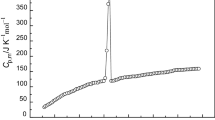Abstract
The paper is aimed at rationalizing relationships between the structure of inorganic compounds in condensed phases and their melting and boiling points. It is documented that the main factor governing both points is their molecular or polymeric nature. In case of polymeric ionic compounds, the higher actual charge bearing by the ions involved, the higher their melting/boiling points. In case of covalent polymers, the value of both points increases with polymer dimensionality (1D → 2D → 3D polymers) and with the number and energy of the respective covalent bonds. In case of molecular compounds, both points depend on the weight and shape of molecules, the presence of hydrogen bonds, and electric quadrupole moment.






Similar content being viewed by others
References
Abramowitz, R., Yalkowsky, S.H.: Melting point boiling point and symmetry. Pharm. Res. 7, 942–947 (1990)
Aldridge, S., Blake, A.J., Downs, A.J., Gould, R.O., Parsons, S., Pulham, C.R.: Some tetrahydroborate derivatives of aluminium: crystal structures of dimethylaluminium tetrahydroborate and the α and β phases of aluminium tris(tetrahydroborate) at low temperature. Dalton Trans. (1997) 1007–1012
Allmann, R., Hinek, R.: The introduction of structure types into the Inorganic Crystal Structure Database ICSD. Acta. Crystallogr. Sect. A Found. Crystallogr. A 63, 412–417 (2007). doi:10.1107/S0108767307038081.
Barbe, J.: Convenient relation for the estimation of bond ionicity in A-B type compounds. J. Chem. Educ. 60, 640–642 (1983)
Battaglia, R.M., Buckingham, A.D., Neumark, D., Pierens, R.K., Williams, J.H.: The quadrupole moments of carbon dioxide and carbon disulphide. Mol. Phys. 43, 1015–1020 (1981)
Brown, R.J.C., Brown, R.F.C.: Melting Point and Molecular Symmetry. J. Chem. Educ. 77, 724–731 (2000). doi:10.1021/ed077p724
Chickos, J.S., Nichlos, G.: Simple relationships for the estimation of melting temperatures of homologous series. J. Chem. Eng. Data 46, 562–573 (2001)
Cordero, B., Gomez, V., Platero-Prats, A.E., Reves, M., Echeverrıa, J., Cremades, E., Barragan, F., Alvarez, S.: Covalent radii revisited. Dalton Trans. (2008). doi:10.1039/b801115j
Cox, J.D., Angus, T., Armstrong, G.T., Freeman, R.D., Laffitte, M., Schneider, G.M., Somsen, G., Alcock, C.B., Gilles, P.W.: Notation for states and processes, significance of the word standard in chemical thermodynamics, and remarks on commonly tabulated forms of thermodynamic functions. Pure Appl. Chem. 54, 1239–1250 (1982)
Guthrie, M., Tulk, C.A., Molaison, J., dos Santos, A.M.: Local structural motifs and extended-range order in liquid and solid ammonia under pressure. Phys. Rev. B 85, 184205 (2012). doi:10.1103/PhysRevB.85.184205
Haynes, W.M. (ed.): Handbook of Chemistry and Physics, 95rd edn. CRC Press, Boca Raton (2014)
King, R.B. (Ed.): Encyclopedia of Inorganic Chemistry (2nd. Ed.). Wiley, Chichester (2005), ISBN-10: 0-470-86078-2
Lindemann, F.A.: The calculation of molecular vibration frequencies. Physik. Z. 11, 609–612 (1910)
McDonald, R.C., Hau, H.H., Eriks, K.: Crystallographic studies of tin(II) compounds. I. Crystal structure of tin(II) fluoride, SnF2. Inorg. Chem. 15, 762–765 (1976). doi:10.1021/ic50158a003
Mebane, R.C., Schanley, S.A., Rybolt, T.R., Bruce, D.C.: The correlation of physical properties of organic molecules with computed molecular surface areas. J. Chem. Educ. 76, 688–693 (1999)
Meden, A.: Inorganic Crystal Structure Prediction—a dream coming true? Acta Chim. Slov. 53, 148–152 (2006)
Nyburg, S.C., Ozin, G.A., Szimanski, J.T.: The crystal and molecular structure of bismuth trichloride. Acta Crystallogr. B 27, 2298–2304 (1971). doi:10.1107/S0567740871005776.
Nieboer, J.: The preparation and characterization od molybdenum and tungsten sulphide fluorides. MS-thesis, university of lethbridge, Canada (2007). https://www.uleth.ca/dspace/bitstream/handle/10133/668/nieboer,%20jared.pdf?sequence=1
Nigsch, F., Bender, A., van Buuren, B., Tissen, J., Nigsch, E., Mitchell, J.B.O.: Melting point prediction employing k-nearest neighbor algoritms and genetic parameter optimization. J. Chem. Inf. Model. 46, 2412–2422 (2006)
Paine, R.T., Asprey, L.B.: Reductive fluoride elimination synthesis of transition metal fluorides. Synthesis of molybdenum pentafluoride and molybdenum tetrafluoride. Inorg. Chem. 13, 1529–1531 (1974). doi:10.1021/ic50136a059
Perry, D.L.: Handbook of Inorganic Compounds (2nd Ed.). CRC Press, ISBN-13: 978-1439814611 (2011).
Pyykkö, P.: Refitted tetrahedral covalent radii for solids. Phys.Rev. B 85, 024115 (2012). doi:10.1103/PhysRevB.85.024115
Rich, R.L.: The mythical dependence of boiling points on molecular mass. Univ. Chem. Educ. 7, 35–36 (2003)
Singh, S., Murthy, A.S.N., Rao, C.N.R.: Spectroscopic studies of hydrogen bonding in donor-acceptor systems. Trans. Faraday Soc. 62, 1056–1066 (1966). doi:10.1039/TF9666201056
Wasserscheid, P., Keim, W.: Ionic liquids—new “solutions” for transition metal catalysis. Angew. Chem. Int. Ed. 39, 3772–3789 (2000). doi:10.1002/1521-3773(20001103)39:21<3772:AID-ANIE3772>3.0.CO;2-5
Welton, T.: Room-temperature ionic liquids. Solvent for synthesis and catalysis. Chem. Rev. 99, 2071–2083 (1999). doi:10.1021/cr980032t
Williams, J.H.: The Molecular electric quadrupole moment and solid-state architecture. Acc. Chem. Res. 26, 593–598 (1993)
Acknowledgments
This work was supported by the VEGA Grant No. 1/0543/15.
Author information
Authors and Affiliations
Corresponding author
Rights and permissions
About this article
Cite this article
Šima, J. Structure-related melting and boiling points of inorganic compounds. Found Chem 18, 67–79 (2016). https://doi.org/10.1007/s10698-015-9228-x
Published:
Issue Date:
DOI: https://doi.org/10.1007/s10698-015-9228-x




